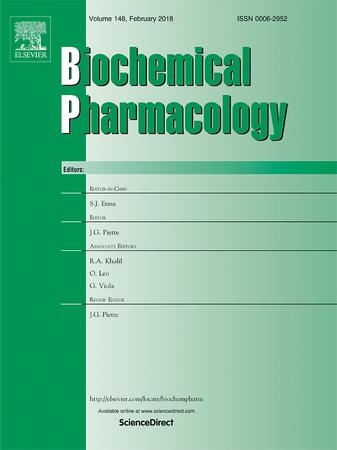IRF8和RUNX1通过上调LINC01806共同调控尿源性肾祖细胞的衰老和损伤
IF 5.3
2区 医学
Q1 PHARMACOLOGY & PHARMACY
引用次数: 0
摘要
来自健康个体的尿源性肾祖细胞(UdRPCs)已被确定具有修复肾脏损伤的潜力。然而,udrpc在慢性肾脏疾病(CKD)患者中是否保留其功能仍不确定。在这项研究中,UdRPCs从健康个体和CKD患者中分离出来。值得注意的是,在CKD患者的UdRPCs中观察到衰老细胞,衰老细胞随着CKD的严重程度而增加,阻碍了肾组织损伤的修复,加剧了CKD的进展。这种衰老表型的特征是增殖减少,肾损伤标志物1 (KIM-1)表达增加,衰老相关分泌表型(SASP)增强。转录组学分析显示,长基因间非编码RNA 01806 (LINC01806)与udrpc损伤和衰老有显著相关性。LINC01806激活可调节KIM-1和衰老相关因子(p53、p21和p16)的表达,通过刺激MAPK通路促进SASP分泌,从而诱导udrpc损伤和衰老。从机制上讲,IRF8-RUNX1复合物与LINC01806的启动子结合,促进其在细胞核中的表达。我们的发现从一个新的角度阐明了CKD的发病机制,更重要的是,为药物筛选和潜在的治疗干预提供了新的靶点。本文章由计算机程序翻译,如有差异,请以英文原文为准。

IRF8 and RUNX1 cooperatively regulate the senescence and damage of urine-derived renal progenitor cells by upregulating LINC01806
Urine-derived renal progenitor cells (UdRPCs) from healthy individuals have been identified as having the potential to repair kidney damage. However, it remains uncertain whether UdRPCs retain their functionality in chronic kidney disease (CKD) patients. In this study, UdRPCs were isolated from healthy individuals and CKD patients. Notably, senescent cells were observed in the UdRPCs of CKD patients, which increase with the severity of CKD, hindering the repair of renal tissue damage and exacerbating the progression of CKD. This senescence phenotype is characterized by decreased proliferation, increased expression of kidney injury marker 1 (KIM-1), and an enhanced senescence-associated secretory phenotype (SASP). Transcriptomics analysis revealed a significant correlation between long intergenic non-coding RNA 01806 (LINC01806) and UdRPCs damage and senescence. LINC01806 activation modulates the expression of KIM-1 and senescence-related factors (p53, p21 and p16), promotes SASP secretion by stimulating the MAPK pathway, thereby inducing damage and senescence in UdRPCs. Mechanistically, the IRF8-RUNX1 complex binds to the promoter of LINC01806, promoting its expression in the nucleus. Our findings clarify the pathogenesis of CKD from a new perspective, and more importantly, provide new targets for drug screening and potential therapeutic interventions.
求助全文
通过发布文献求助,成功后即可免费获取论文全文。
去求助
来源期刊

Biochemical pharmacology
医学-药学
CiteScore
10.30
自引率
1.70%
发文量
420
审稿时长
17 days
期刊介绍:
Biochemical Pharmacology publishes original research findings, Commentaries and review articles related to the elucidation of cellular and tissue function(s) at the biochemical and molecular levels, the modification of cellular phenotype(s) by genetic, transcriptional/translational or drug/compound-induced modifications, as well as the pharmacodynamics and pharmacokinetics of xenobiotics and drugs, the latter including both small molecules and biologics.
The journal''s target audience includes scientists engaged in the identification and study of the mechanisms of action of xenobiotics, biologics and drugs and in the drug discovery and development process.
All areas of cellular biology and cellular, tissue/organ and whole animal pharmacology fall within the scope of the journal. Drug classes covered include anti-infectives, anti-inflammatory agents, chemotherapeutics, cardiovascular, endocrinological, immunological, metabolic, neurological and psychiatric drugs, as well as research on drug metabolism and kinetics. While medicinal chemistry is a topic of complimentary interest, manuscripts in this area must contain sufficient biological data to characterize pharmacologically the compounds reported. Submissions describing work focused predominately on chemical synthesis and molecular modeling will not be considered for review.
While particular emphasis is placed on reporting the results of molecular and biochemical studies, research involving the use of tissue and animal models of human pathophysiology and toxicology is of interest to the extent that it helps define drug mechanisms of action, safety and efficacy.
 求助内容:
求助内容: 应助结果提醒方式:
应助结果提醒方式:


